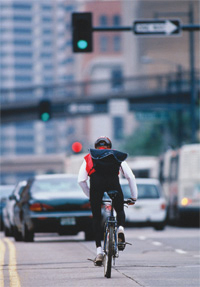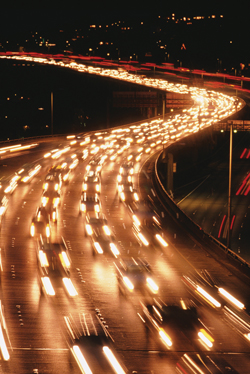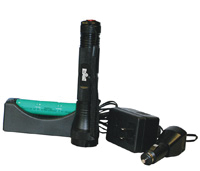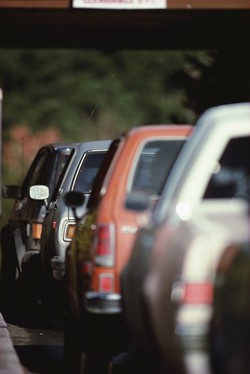VEHICLE AND DRIVER MANAGEMENT
AAA OF NEW YORK
 CREATING BIKE-FRIENDLY BOROUGHS CREATING BIKE-FRIENDLY BOROUGHS
If you haven't been to New York City in a while, you might be surprised by the increase in green-painted bike lanes and other bicycle-centric enhancements. The city's Department of Transportation (NYCDOT) has been adding the bike lanes, as well as bike racks and protected bike paths, as part of the mayor's PlaNYC to create bike-friendly streets.
"We have seen a 77-percent increase in the number of cyclists in New York City since 2000, and we are working hard to ensure that the streets are as safe as possible for them," says NYCDOT Commissioner Janette Sadik-Khan. The city also wants to double the number of bicycle commuters by 2015, she adds.
Also, the city launched the LOOK campaign earlier this year with AAA New York, Transportation Alternatives and the New York Bicycling Coalition, among other groups, to educate motorists and cyclists about bicycle traffic laws and safety.
By 2009, the city intends to finish expanding the number of bike-lane miles from 220 to 420—currently, the overall miles in place equal 331. It also built a protected bike path on Manhattan's Ninth Avenue, separating cyclists from traffic, and intends to install a similar path on Eighth Avenue beginning in November. The city also has distributed 1 million cycling maps and 15,000 bicycle helmets and installed more than 1,000 bike racks, bringing the total to 5,000.
"We are supportive of these bicycle improvements, so long as they accommodate bicyclists in a safe way," says Mark Kulewicz, AAA New York's traffic engineer. "Also, bicyclists need to use the bike lanes and obey traffic controls, and motorists need to be on the lookout for bicyclists and respect the use of the bike lanes."
CAMPAIGN TO PREVENT VEHICLE FIRES

Vehicle fires reached their lowest point in 20 years in 2006, but AAA and the National Fire Protection Association (NFPA) have launched a public awareness campaign to further reduce the number of fires and related injuries and deaths.
An annual report from the NFPA shows that 2006 saw the fewest vehicle fires—approximately 278,000—since it began recording this data in 1980. However, the fires also caused 490 deaths, 1,200 injuries and $1.3 billion worth of property damage in 2006.
From 2002 to 2005, half of all vehicle fires were caused by mechanical failures or malfunctions due to worn or broken auto parts—evidence that it pays to properly maintain your vehicle, notes John Nielsen, director of AAA's Approved Auto Repair network.
To prevent vehicle fires, AAA recommends that you follow the vehicle manufacturer's maintenance schedules and check your car for fluid leaks, loose wiring, broken hoses or cracked insulation. Also, have a professional technician inspect your vehicle at least once a year.
 FEWER HIGHWAY DEATHS FEWER HIGHWAY DEATHS
In 2007, highway deaths dropped to their lowest level in more than a decade—the result of safer vehicles, aggressive law enforcement, increased seat belt use and fewer alcohol-impaired crashes, the National Highway Traffic Safety Administration reports.
Crash-related fatalities fell to 41,059 last year from 42,708 in 2006—a low not seen since 1994, when 40,716 people were killed in traffic crashes. New York State saw an 8.3 percent drop, or 122 fewer deaths, than in 2006. People are also driving less—data shows a 2.8 percent drop in vehicle-miles traveled during the first half of 2008. While decreases in driving holds potential for fewer crashes and deaths, officials explained that some of these gains could be offset by continued increases in motorcycle and scooter use. (Motorcycle deaths, for the 10th straight year, increased from 4,837 in 2006 to 5,514 in 2007.)
"The reduction in deaths and injuries in 2007 is promising, but much more can and should be done to bring about additional reductions," adds Kathleen Marvaso, AAA's vice president of public affairs. "We should not simply look to a decrease in driving as the answer in reducing highway deaths."
 PRODUCT REVIEW: FLASHLIGHT TO THE RESCUE PRODUCT REVIEW: FLASHLIGHT TO THE RESCUE
A section of Murphy's Law says that you'll always have car trouble when it's least convenient, usually when it's raining or at night. That said, a flashlight might be one of the most useful and basic tools to store in your vehicle. Left dormant for months at a time, however, the batterypowered light will be useless when you need it most.
Super bright Rechargeable 3 Watt Flashlight to the rescue! Available from Duluth Trading Co. (www.duluthtrading.com; 800/505/8888; $39.50; product code #82080), the flashlight features a bright L.E.D. light that the manufacturer claims is "deeper and brighter than a Krypton unit." Since we were fresh out of bulbs from Superman's birthplace, we can only take their word for it, but the light does throw a brilliant beam that illuminates the darkest night. Good for three hours of continuous use, if the batteries do die, you can re-energize them by removing the pack and placing it in a recharger that conveniently plugs into a wall socket or vehicle power outlet. It takes six hours to fully recharge. Solid aluminum construction makes the unit durable and an included lanyard keeps it close by. Great for when Murphy pays his inevitable visit.
GLANCE AGAIN AT YOUR CAR'S WINDSHIELD

Got your seat belt fastened, plenty of safety features such as antilock brakes and enough air bags for your protection in a crash? Don't forget to check your vehicle's windshield, too, which also plays a pivotal role in automobile safety, AAA warns.
Windshields support the roof of your vehicle, thereby preserving the structural integrity of the passenger compartment and keeping it from collapsing and crushing the driver and any passengers. When combined with using a seat belt, windshields also protect you from being ejected during head-on collisions, rollovers and crashes.
A maintained windshield is vital, since research from the National Highway Traffic Safety Administration (NHTSA) indicates that windshield integrity might be a crucial factor in surviving a crash. The NHTSA reports that more than 40,000 people are killed and 5 million are injured in highway crashes. Notably, more than 30 percent of these incidents are caused by passengers being ejected from the vehicle or injured during rollovers.
With this in mind, AAA encourages drivers with cracked or damaged windshields to seek the advice of an auto glass technician who is certified by the National Glass Association (NGA). You may find the NGA-certified technician nearest you by visiting www.myautoglass.org.
This is especially important since no laws govern windshield replacement. An improperly replaced windshield could, and sometimes does, become detached from the vehicle during airbag deployment, from the force of a collision or when the car rolls or flips over. With the windshield displaced, the effectiveness of the vehicle's safety response system is seriously compromised.
There are thousands of responsible auto glass companies that perform high-quality, safe windshield replacement, and some that do not. How can you tell the difference? The NGA recommends that consumers ask prospective auto glass service providers if they:
- Have NGA-certified technicians
- Endorse the Auto Glass Replacement Safety Standard (AGRSS)
- Use the manufacturers' recommended urethane adhesive
- Review the dos and don'ts of post-installation usage with customers
During the installation process, you should also watch to see if the technician checks for a passenger-side airbag and uses urethanerated glass. The technician should remove the old sealant, leaving an approximately 1/16-inch bonding surface. Technicians should also wear gloves to avoid contaminating the bonding surfaces—both the glass and the area on the vehicle where the glass is to be set should be clean and primed.
The NGA also recommends that you ask to see the manufacturer's expiration date on all preps, primers and adhesives that will be used during the windshield replacement. If any of these materials are dated past the expiration date, do not allow the installation to begin until the technician finds acceptable materials. If the installation is already in process, ask that the technician stop and start the installation again from scratch after all bonding surfaces have been thoroughly cleaned.
After the installation is complete, inspect the work carefully. From outside the vehicle, check to see if:
- The windshield is perfectly centered on the car
- The distance between the left side and the right side of the windshield and the auto body is the same
- The molding fits around the circumference of the windshield and there are no visible gaps
- The molding is flat and the glass is flush to the vehicle's body. This is probably the most important element. To be done properly, windshield replacement requires the use of the best materials technology can provide and the skills of highly trained and detail oriented technicians.
If you are seeking a qualified facility to repair or replace your windshield, AAA recommends you seek one with NGA certified technicians, Original Equipment Manufacturer (OEM) quality replacement glass and adhesives and convenient mobile service at home or work. For more information, visit www.myautoglass.org.
 MORE THAN A MESSAGE MORE THAN A MESSAGE
What bumper stickers tell you about the person behind the wheel.
by Joseph D. Younger
Beware of the car with bumper stickers, trinkets dangling from the mirror and decals on the windows, even if they seem as benign as a college logo. According to a new study, drivers in cars festooned with personalized markers tend to drive more aggressively and express their anger physically on the road.
Researchers at Colorado State University established a link between bumper stickers and road rage. The more bumper stickers and other personal expressions on a car, the greater the likelihood that the drivers would use their vehicle to cut off, tailgate or even ram another car. The tendency to act aggressively proved independent of the bumper stickers' messages; drivers with positive or neutral messages (such as "I Brake for Animals") were just as likely to act as dangerously as those with negative or aggressive messages (such as "Dropkick Bush"). Drivers in cars without bumper stickers also got angry behind the wheel, but they didn't express their anger in physically threatening ways.
The researchers interpreted bumper stickers, window decals and mirror decorations as "territorial markers." Drivers who personalize their cars with stickers and decorations mark their cars as "primary territory," and they take action to defend it—even on "public territory" such as a roadway, where social norms would dictate a less aggressive response. The study appeared in the Journal of Applied Social Psychology.
 COMFORTABLE DRIVING SHOES COMFORTABLE DRIVING SHOES
Held in one position for a long time and straining against the gas pedal's resistance, a driver's foot can suffer from discomfort just like the rest of the body. Proper footwear can make a big difference, but most folks haven't a clue about what's right for their feet. Race car drivers have long known that specialized footwear eases the pain of driving at the limit for hours on end. Now street drivers can enjoy the benefits of shoes designed specifically for driving.
The stylish Piloti Prototipo Driving Shoes (www.piloti.com; $85) make driving less taxing and ease the walk to or from the vehicle. We tried the Prototipo model, which has "roll control" cushions at the back to assist the heel-pivot action that should be used to properly move from throttle to brake. Cushioning on the sides of the shoes reduces heat and vibration from the vehicle, and a special midsole provides greater durability and comfort. A toe spring gives extra support.
What a difference the shoes make. They gave my feet greater dexterity and support. Long trips sailed by, and walking short distances was pleasurable, but don't try running a marathon in these shoes. Available in a host of stylish color combinations, they look good, too.
 WET-WEATHER TIPS WET-WEATHER TIPS
True or not, e-mail tale offers sound advice.
A woman driving along a highway in the rain loses steering control, runs off the road and totals her vehicle. Luckily, she escapes serious injury. A patrolman at the scene explains that her car hydroplaned because she was using cruise control. He advises her never to use cruise control in the rain.
Although the precise location, type of vehicle and other details vary, versions of this story have circulated around the Internet for at least four years in a seemingly endless e-mail chain. AAA members frequently ask about the truth of the tale—especially whether to heed the advice about not using cruise control in the rain. Safety experts can't vouch for the circumstances of the story, but the moral is a good one to follow.
Hydroplaning occurs when a thin film of water gets under your tires, literally lifting them off the pavement. In heavy rain or at high speeds, the treads of tires can't channel water from under the tire fast enough, a layer of liquid builds up and your vehicle skims across the surface with virtually no traction. When driving on wet roads in any vehicle—front, rear or four wheel drive—take these tips:
- Slow down. The faster you travel, the greater the risk of hydroplaning, even in a relatively light shower. Posted speed limits assume ideal conditions, not rainslick pavement.
- Shut off cruise control. Most owner's manuals warn against using cruise control (sometimes called "speed control") in wet or icy conditions. In fact, a few models automatically lock out cruise control when you use the windshield wipers at certain settings.
- Check your tire pressure. Fully inflated tires channel water away better than do underinflated ones, reducing the risk of hydroplaning.
- Pull over if necessary. Experts note that the danger of hydroplaning is greatest during the first few minutes of a storm (when rainwater loosens oil and other substances embedded in the pavement) and whenever rain falls heavily enough to form bubbles on the roadway.
© 2015 TLC Magazine Online, Inc. |